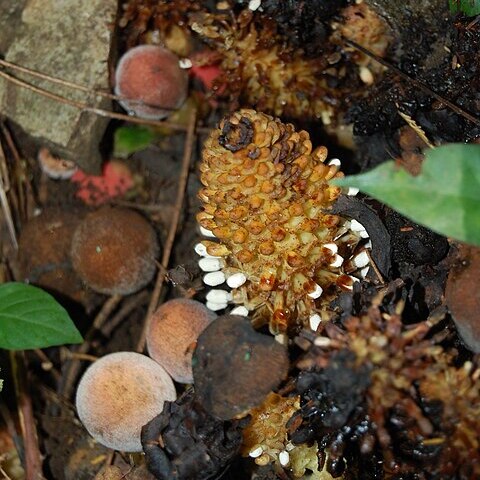Plants monoecious or dioecious. Rhizome branched or unbranched, containing sticky wax (balanophorin), smooth or rugose with small scaly warts and/or stellate lenticels. Leaves opposite, alternate and distichous or spiral, or whorled, sessile, fleshy or scale-like. Inflorescences spadixlike, cylindric, ellipsoid, ovoid-globose, or globose, enlarged after anthesis. Male flowers: pedicellate or sessile, subtended by U-shaped or variously reduced bracts. Perianth 3-6-lobed; lobes ovate, lanceolate, or orbicular, concave, isomorphic or heteromorphic, valvate, reflexed at anthesis. Stamens in a hemispheric or ± elongated synandrium; anthers bilocular, usually as numerous as perianth lobes, straight or sometimes U-shaped with a bend near apex of synandrium, occasionally variously fused or interrupted into locelli, transversely or longitudinally dehiscent; pollen white, subconical or globose, smooth or bullate. Spadicles minute, subclavate to clavate, very numerous, congested on female inflorescence. Female flowers: composed of a pistil, congested on main axis or also on basal stipe of spadicles. Ovary ellipsoid to fusiform, 1-loculed, attenuate toward both ends; ovules anatropous, shortly stiped. Style elongated, persistent. Fruit exocarp crustaceous.
Short unbranched parasitic herbs. Tubers containing wax, simple or branched; surface finely granular to coarsely tessellate, with or without stellate warts. Stem arising from pit at apex of tuber. Leaves 2–40, whorled, opposite, distichous or alternate; base broad. Inflorescence axis globular or elongate. Male flowers bracteate; perianth of 3–6, rarely to 14, tepals. Female flowers about 1 million, subtended by club-shaped spadicles, 0.5-2.5 mm long; perianth absent; style 1; ovary 1-locular; ovule 1. See also Du Puy (1993: 256–257).

